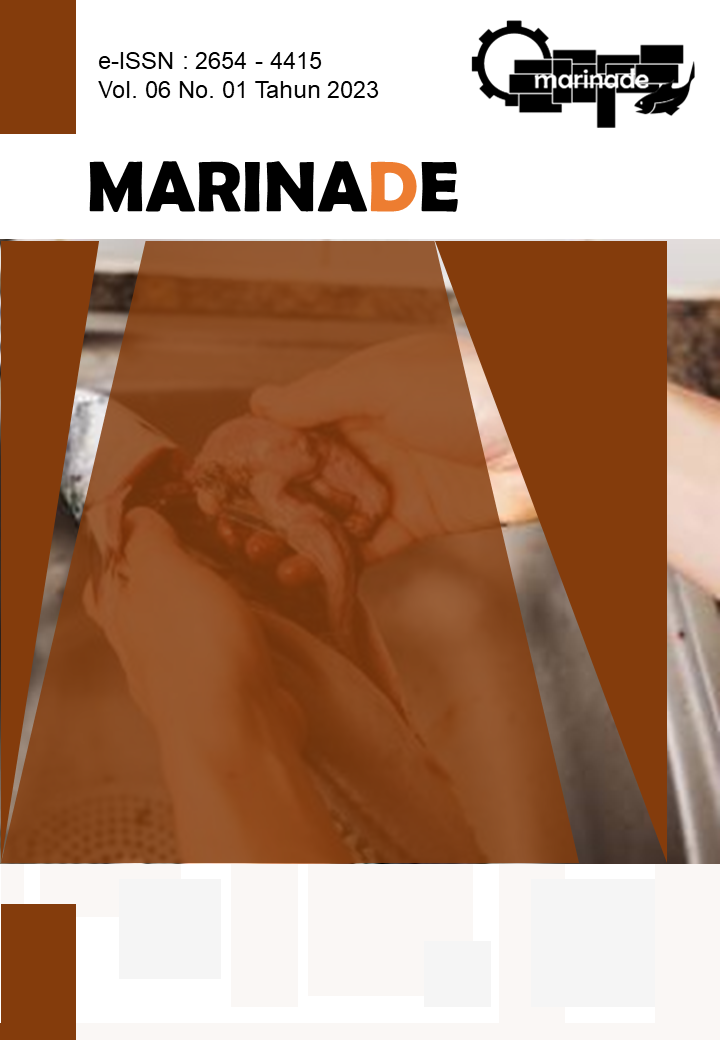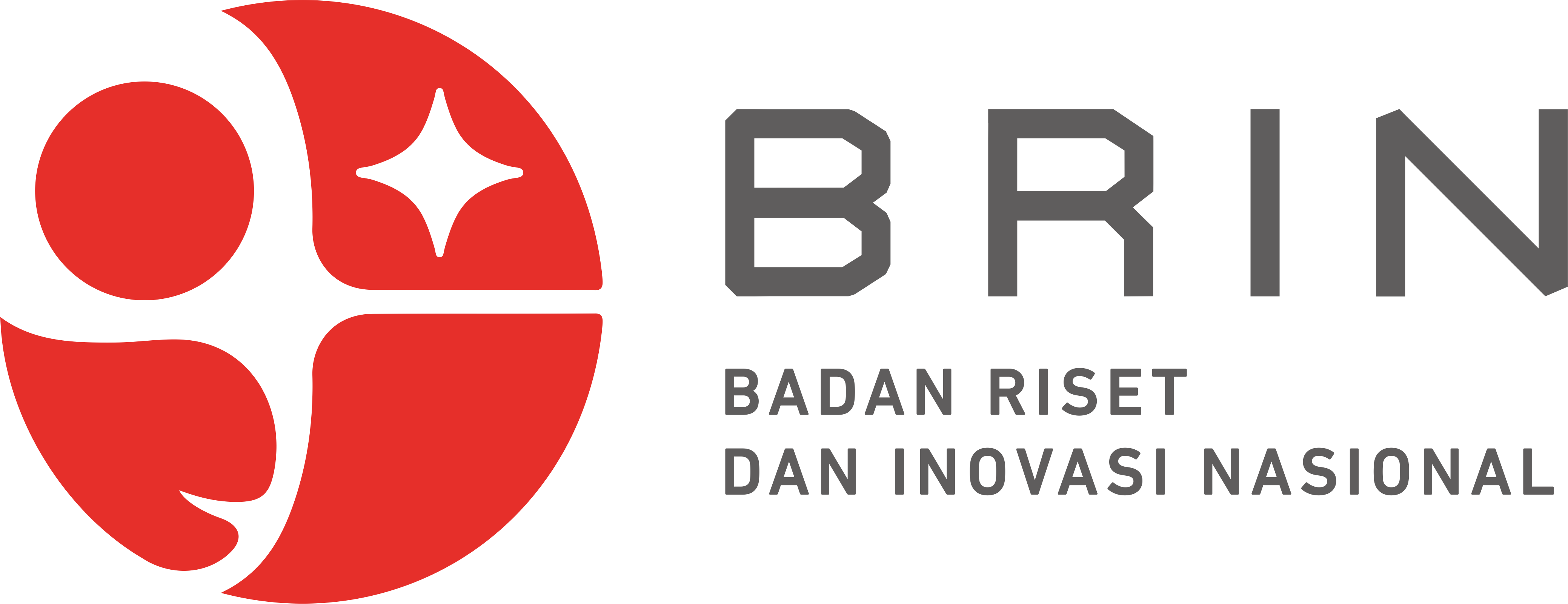IDENTIFIKASI SENYAWA BIOAKTIF PADA KULIT IKAN SEMBILANG (Paraplotosus albilabris) DAN POTENSINYA SEBAGAI ANTIBAKTERI
DOI:
https://doi.org/10.31629/marinade.v6i01.5027Kata Kunci:
antibakteri, komponen bioaktif, ikan sembilang, toksisitasAbstrak
Ikan sembilang adalah salah satu biota perairan yang mengandung senyawa bioaktif. Senyawa bioaktif ini yang memiliki potensi untuk dikembangkan menjadi antikanker, antimikroba, dan antioksidan. Tujuan penelitian ini yaitu untuk mengekstraksi senyawa aktif dan menguji potensinya sebagai anti bakteri. Maserasi dengan menggunakan tiga jenis pelarut organik yang berbeda (etanol, metanol, n heksan) digunakan untuk mengekstrak komponen bioaktif pada kulit ikan sembilang. Parameter uji yang dilakukan yaitu identifikasi komponen bioaktif, uji toksisitas (Brine Sirmp Lethaly Test), dan uji antibakteri (agar difusi). Hasil penelitian ini menunjukkan bahwa pelarut etanol dan metanol mampu mengekstrak lebih banyak komponen bioaktif daripada pelarut n-heksan, nilai LC50 ekstrak kulit ikan sembilang (etanol, metanol, dan n-heksan) yaitu 451,42 ppm; 33853,22 ppm; 29513,84 ppm. Hasil ekstraksi dengan pelarut etanol memiliki zona hambat tertinggi yaitu 93 mm untuk bakteri Staphylococcus aureus dan 74 mm untuk bakteri Escherichia coli. Diduga bioaktif tersebut tergolong senyawa bioaktif polar.
Referensi
Al-Khayri, J. M., Sahana, G. R., Nagella, P., Joseph, B. V., Alessa, F. M., & Al-Mssallem, M. Q. (2022). Flavonoids as potential anti-inflammatory molecules: aa review. Molecules, 27(9): 1-24. https://doi.org/10.3390/molecules27092901
Syahputri, E. A., Oktavia, Y. Amrizal, S. N. 2022. Penapisan kapang endofit asal Thallasia hemprichii sebagai penghasil antimikroba. Jurnal Ilmu Dan Teknologi Kelautan Tropis, 14(2), 233–241. https://doi.org/10.29244/jitkt.v14i2.39490
Andini, A., Prayekti, E., Wulandari, D., Nidianti, E. 2020. Cytotoxicity assay using brine shirmp lethality test on collagen-chitosan wond dressing sterilized by ultraviolet light. Indonesian Journal of Medical Laboratory Science and Technology, 2(1). https://doi.org/10.33086/ijmlst.v2i1.1467
Aspmo, S. I., Horn, S. J., Eijsink, V. G. H. 2005. Use of hydrolysates from Atlantic cod (Gadus morhua L.) viscera as a complex nitrogen source for lactic acid bacteria. FEMS Microbiology Letters, 248(1): 65–68. https://doi.org/10.1016/j.femsle.2005.05.021
Azalia, D., Rachmawati, I., Zahira, S., Andriyani, F., Sanini, T. M., Rahmi Aulya 2023). Uji Kualitatif Senyawa Aktif Flavonoid Dan Terpenoid Pada Beberapa Jenis Tumbuhan Fabaceae Dan Apocynaceae Di Kawasan Tngpp Bodogol. Bioma : Jurnal Biologi Makassar (on Line). 8: 32–43.
Baehaki, A., Widiastuti, I., Nainggolan, C., Gofar, N. 2020. Antioxidant activities of snakehead (Channa striata) fish skin: Peptides hydrolysis using protease TP2 isolate from swamp plant silage. Potravinarstvo Slovak Journal of Food Sciences, 14:379-384. https://doi.org/10.5219/1264
Barbosa, F., Pinto, E., Kijjoa, A., Pinto, M., Sousa, E. 2020. Targeting antimicrobial drug resistance with marine natural products. International Journal of Antimicrobial Agents. 56(1):1-29. https://doi.org/10.1016/j.ijantimicag.2020.106005
Bertrand, B., Munoz-Garay, C. 2019. Marine antimicrobial peptides: A promising source of new generation antibiotics and other bio-active molecules. International Journal of Peptide Research and Therapeutics, 25(4): 1441–1450. https://doi.org/10.1007/s10989-018 9789-3
Chan, W., Shaughnessy, A. E. P., Van den Berg, C. P., Garson, M. J., Cheney, K. L. 2021. The validity of brine shrimp (Artemia sp.) toxicity assays to assess the ecological function of marine natural products. Journal of Chemical Ecology. 47:(10–11): 834–846. https://doi.org/10.1007/s10886-021-01264-z
Dari, B., Ekologi, A., Dan, S., Untuk, E., & Bencana, M. (2009). Prosiding Seminar Nasional Biologi VII.
Das, T. K., Banerjee, D., Chakraborty, D., Pakhira, M. C., Shrivastava, B., Kuhad, R. C. 2012. Saponin: Role in animal system. Veterinary World, 5(4):248–254. https://doi.org/10.5455/vetworld.2012.248-254
Eghtedari, M., Porzani, S. J., Nowruzi, B. 2021. Anticancer potential of natural peptides from terrestrial and marine environments: A review. In Phytochemistry Letters. 42:87-103. https://doi.org/10.1016/j.phytol.2021.02.008
Gunathilaka, T. L., Samarakoon, K., Ranasinghe, P., Peiris, L. D. C. 2020. Antidiabetic potential of marine brown algae - A Mini Review. Journal of Diabetes Research, 2020. https://doi.org/10.1155/2020/1230218
Guo, C., Zhu, Z., Yu, P., Zhang, X., Dong, W., Wang, X., Chen, Y., Liu, X. 2019. Inhibitory effect of iota-carrageenan on porcine reproductive and respiratory syndrome virus in vitro. Antiviral Therapy. 24(4): 1-19. https://doi.org/10.3851/IMP3295
Hammado, Illing, 2013.. Identifikasi senyawa bahan aktif alkaloid pada tanaman lahuna (Eupatorium odoratum). Jurnal Dinamika, 04(2), 1–18.
Iswandi, I., Oktavia, Y., Suhandana, M., & Fadli Ilhamdy, A. 2022. Nilai Proksimat dan Profil Asam Amino Ikan Sembilang (Paraplotosus albilabris) dari Perairan Bintan, Kepulauan Riau. Jurnal FishtecH, 10(2), 102–108. https://doi.org/10.36706/fishtech.v10i2.15388
Jelita, S. F., Setyowati, G. W., Ferdinand, M., Zuhrotun, A., Megantara, S. 2020. Uji Toksisistas Infusa Acalypha Simensis dengan Metode Brine Shrip Lethality test (BSLT). Jurnal Farmaka, 18(1), 14–22.
Lee, Y., Bilung, L. M., Sulaiman, B., & Chong, Y. L. 2020. The antibacterial activity of fish skin mucus with various extraction solvents and their in-vitro evaluation methods. International Aquatic Research. 12(1): 1-21. https://doi.org/10.22034/IAR(20).2020.670998
Leh, M., Sasekumar, A., Chew, L. 2012. Feeding Biology of Eel Catfish Plotosus Canius Hamilton In a Malaysian Mangrove Estuary And Mudflat. The Raffles Bulletin of Zoology. 60(2), 551–557.
Lestari, N. K. L., Suardana, I. W., Sukrama, I. D. M. 2019. Karakteristik fisikokimia dan uji aktivitas antimikroba Bakteriosin dari isolat bakteri asam laktat 15B hasil isolasi kolon sapi Bali. Buletin Veteriner Udayana. https://doi.org/10.24843/bulvet.2019.v11.i01.p11
Lv, C., Han, Y., Yang, D., Zhao, J., Wang, C., Mu, C. 2020. Antibacterial activities and mechanisms of action of a defensin from manila clam Ruditapes philippinarum. Fish and Shellfish Immunology. 103. https://doi.org/10.1016/j.fsi.2020.05.025
Mahanand, S. S., Devi, D., Sharma, S., Wangkheirakpam, R. 2019. Fish waste utilization with reference to fish protein hydrolisate-a review. Fisher Technology. 56.
Mardiana, N., Waluyo, S., Ali, M. 2014. Analisis kualitas ikan sembilang (Paraplotosus albilabris) asap di Kelompok Pengolahan Ikan "Mina Mulya" Kecamatan Pasir Sakti Lampung Timur. Jurnal Teknik Pertanian Lampung. 3(3): 283–290.
Martiningsih, N. W. 2013. Skrining awal ekstrak etil asetat spons Leucetta sp. sebagai antikanker dengan metode brine shrimp lethality test (BSLT). Seminar Nasional FMIPA UNDIKSHA III, 382–386.
Nurilmala, M., Fauzi, S., Mayasari, D., Batubara, I. 2019. Collagen extraction from yellowfin tuna (Thunnus albacares) skin and its antioxidant activity. Jurnal Teknologi. 81(2):1-9. https://doi.org/10.11113/jt.v81.11614
Park, I. Y., Park, C. B., Kim, M. S., Kim, S. C. 1998. Parasin I, an antimicrobial peptide derived from histone H2A in the catfish, Parasilurus asotus. FEBS Letters. 437(3), 258–262. https://doi.org/10.1016/S0014-5793(98)01238-1
Petrova, I., Tolstorebrov, I., Zhivlyantseva, I., & Eikevik, T. M. 2021. Utilization of fish protein hydrolysates as peptones for microbiological culture medias. Food Bioscience: 42. https://doi.org/10.1016/j.fbio.2021.101063
Purwaningsih, S., Rimbawan, Priosoeryanto, B. P. 2008. Active components extraction from matah merah mollusks (Cerithidea obtusa) for use as anti-cancer for Cells Line. Jurnal Ilmu-Ilmu Perairan Dan Perikanan Indonesia. 15(2): 103–108.
Qureshi, M. N., Stecher, G., Bonn, G. K. 2014. Quality control of herbs: Determination of amino acids in Althaea officinalis, Matricaria chamomilla and Taraxacum officinale. Pakistan Journal of Pharmaceutical Sciences, 27(3): 459–462.
Ranjini, S., Muniasamy, S., Rameshkumar, G., Rajagopal, T., Sivakumar, T., Ponmanickam, P. 2020. Bactericidal activity of skin mucus and skin extracts of Catla catla and Channa striatus. Acta Biologica Szegediensis. 64(1). https://doi.org/10.14232/ABS.2020.1.11-16
Sheih, I. C., Wu, T. K., Fang, T. J. 2009. Antioxidant properties of a new antioxidative peptide from algae protein waste hydrolysate in different oxidation systems. Bioresource Technology. 100(13): 3419–3425. https://doi.org/10.1016/j.biortech.2009.02.014
Sila, A., Bougatef, A. 2016. Antioxidant peptides from marine by-products: Isolation, identification and application in food systems. A review. Journal of Functional Foods, 21, 10–26. https://doi.org/10.1016/j.jff.2015.11.007
Valero, Y., Saraiva-Fraga, M., Costas, B., Guardiola, F. A. 2020. Antimicrobial peptides from fish: beyond the fight against pathogens. In Reviews in Aquaculture. 12(1). https://doi.org/10.1111/raq.12314
Wai, A. L. S., Man, R. C., Mudalip, S. K. A., Sulaiman, S. Z., Arshad, Z. I. M., Shaarani, S. M. 2020. Effects of chemical hydrolysis operating parameters on the production of antioxidant from fish waste. IOP Conference Series: Materials Science and Engineering, 991(1). https://doi.org/10.1088/1757-899X/991/1/012062
Wulansari, E. D., Lestari, D., & Khoirunissa, M. A. 2020. Kandungan terpenoid dalam daun ara (Ficus carica L.) sebagai agen anti bakteri terhadap bakteri Methicillin-Resistant Staphylococcus aureus. Pharmacon, 9(2):219. https://doi.org/10.35799/pha.9.2020.29274
Zhang, L., Zhao, G. X., Zhao, Y. Q., Qiu, Y. T., Chi, C. F., & Wang, B. 2019. Identification and active evaluation of antioxidant peptides from protein hydrolysates of Skipjack tuna (Katsuwonus pelamis) head. Antioxidants, 8(8). https://doi.org/10.3390/antiox8080318
Zubair, M. S., Lallo, S., Putra, M. Y., Hadi, T. A., & Jantan, I. 2018. Antibacterial and cytotoxic activities of sponges collected off the coast of Togean Islands, Indonesia. Pharmacognosy Journal, 10(5). https://doi.org/10.5530/pj.2018.5.168
Unduhan
Diterbitkan
Terbitan
Bagian
Lisensi
Hak Cipta (c) 2023 Marinade

Artikel ini berlisensiCreative Commons Attribution-NonCommercial-ShareAlike 4.0 International License.







